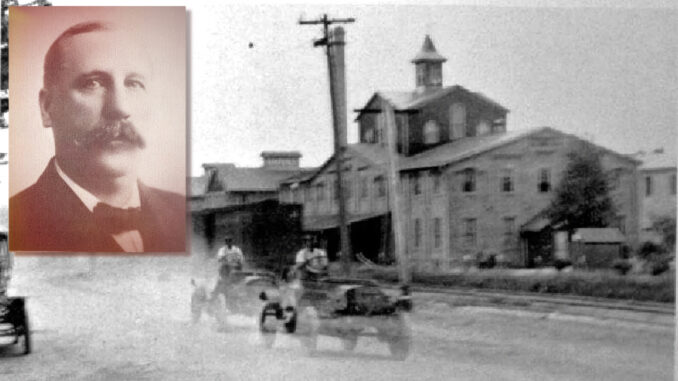
PASCACK VALLEY—In the featured photograph, taken in the early 1900s, two early automobiles kick up dust in a race on Broadway in Park Ridge. The drivers are heading in the direction of Park Avenue. In the background, the railroad tracks and the Mittag & Volger typewriter ribbon factory.
Automobiles were new technology in a world that had always relied on horse-drawn carriages. It was not a foregone conclusion that motorized vehicles would one day become ubiquitous and even replace the horse entirely. Many people viewed these fast new machines either with skepticism or as a downright nuisance. They zipped between wagons, scared horses, and led to plenty of close-calls and also some serious accidents. In 1902 the Pascack Valley’s first speed limits were imposed by local ordinances. Most of our towns set the limit at 8 miles per hour.
In those days of the early 20th century, when both types of horsepower shared our roads, automobiles were thought of mostly as playthings for the wealthy, and thus owning one was a status symbol rather than a necessity. The vast majority of people still viewed the tried-and-true horse as the mode of transportation that would carry America into the future.
As a hobby for rich men, it makes sense that the first person to own an automobile in Park Ridge was Frank O. Mittag. That’s the same Mittag whose name appeared earlier in this article as co-owner of the typewriter ribbon factory. Business was booming, and the company had made Mittag a wealthy man.
At one time Mittag & Volger, headquartered in rural Park Ridge, was the largest producer of typewriter ribbon and carbon paper in the world, with distribution offices in New York, Chicago, Paris, and London. Mittag and his family lived on South Maple Avenue near the factory. He was one of the town’s most prominent citizens, active in politics and other local affairs.
Mittag took delivery of his “racing machine” on March 25, 1902. That afternoon, he and factory foreman Harry Stark donned their motoring goggles and zoomed all over the country lanes of Bergen and Passaic counties, returning home without a mishap. A local newspaper described it as “a pretty good performance on an initial trip with one of those cantankerous machines.” Mittag’s neighbors found it baffling that he had purchased the automobile just months after building beautiful new horse stables on his property.
A couple of weeks later, Mittag’s machine broke down while he was driving in Nyack. He had to hire a horse-drawn carriage to bring him back to Park Ridge while the car was taken for repairs. (One has to wonder whether any of his neighbors got a chuckle out of that one.) Days later, he left the community speechless when he bought two new horses and a second automobile.
“His neighbors are now guessing whether an airship will furnish the next sensation,” one report said.
It seems the Mittag family went all-in on automobiles. The factory owner created a stir in Atlantic City in July 1904 when he pulled up in front of the luxurious Marlborough House hotel with three big touring cars. What at first seemed to be an automobile club was
actually the Mittag family entourage—a trio of cars, all owned by him, carrying 10 family members and several servants.
The typewriter ribbon business was lucrative, indeed.A dusty matchup between two early autos on Broadway in Park Ridge. In the background is the Mittag & Volger typewriter ribbon factory. The factory fronted Park Avenue in the present location of Veterans Park and stretched south along the railroad tracks. Frank O. Mittag, Park Ridge’s first automobile owner.
